6 Ways to Use Garlic in the Garden
This post may contain affiliate links. Read my full disclosure here.
This post is for the garlic lovers – or those who aren’t sure if they like garlic but do like to use natural and organic practices in their gardens. It turns out that this fragrant bulb is good for more than just cooking, and can be a real helpmate around the yard and garden. So – without further ado – 6 Ways to Use Garlic in the Garden and Yard.
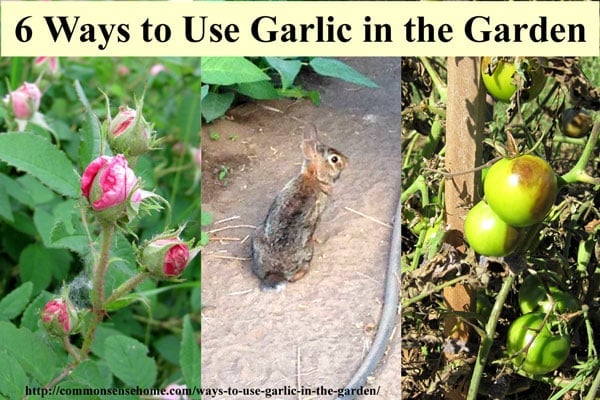
#1 – Use Garlic to Protect Fruit Trees
Garlic planted at the base of fruit trees makes a great partner in your permaculture guild. Garlic and other alliums such as chives and onions have flowers that attract a variety of beneficial insects. Their strong scent also deters browsers, and may be effective as a peach borer deterrent.
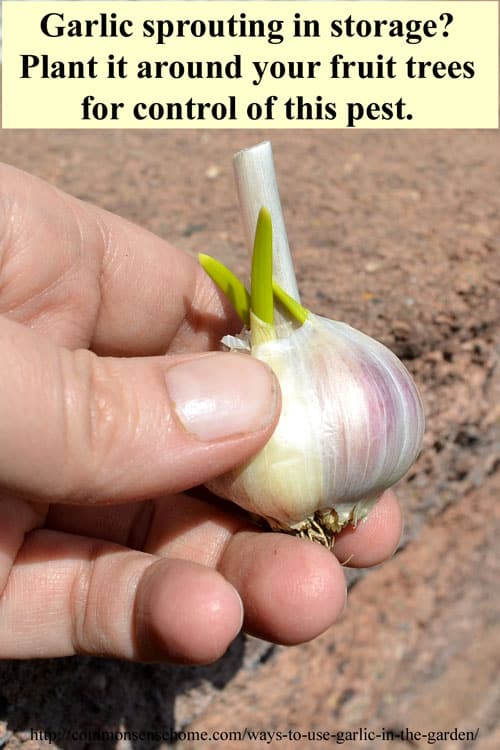
#2 – Use Garlic as a Companion Plant in the Garden
From Carrots Love Tomatoes, Louise Riotte recommends teaming up your garlic with your roses and your tomatoes to keep pests at bay. She also recommends avoiding interplanting garlic with peas and beans, because alliums may slow down the growth of the legumes, but I have grown them as next door neighbors in the garden with no problems.
#3 – Use Garlic as a Fungicide
If you spot gray or white powdery spots on your plants, odds are you’re dealing with some sort of mildew or fungus. To make a simple garlic fungicide, puree 5-10 garlic cloves with a pint of water in a blender, let steep for an hour, strain, and spray on plants. Garlic can also be used as an insecticide, so watch out for beneficial insects while spraying.
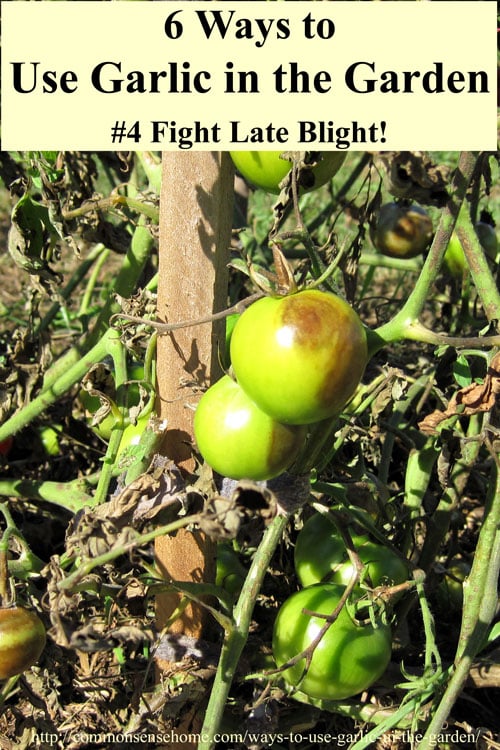
#4 – Use Garlic for Controlling Late Blight
Late blight is caused by the fungus-like oomycete pathogen Phytophthora infestans. It was responsible for the Irish potato famine, and has decimated tomato and potato crops in different areas in recent years. We were hit with it here late in 2010. It turns potato tubers into black mush, and makes plant foliage look like it was killed by frost. Tomatoes get brown lesions and then rot. Late blight spreads the fastest in warm (60-80°F, 15.5-26.7°C), wet weather.
Typical practices to control and eliminate late blight include planting certified disease free plant starts, destroying infected plants and tubers, and treating with fungicides during the growing season. Cornell University’s Fact Sheet on Late Blight of Tomatoes and Potatoes goes into more detail on identification and treatment. In the article, “Management of Late Blight with Alternative Products“, where they look at plant extracts for treating late blight, they state that:
“One of the most effective was extract of garlic gloves, which at 1 or 2% completely inhibited zoospore formation (Cao and van Bruggen 2001; Wang et al. 2001) and colony growth of P. infestans (Cao and van Bruggen 2001).”
So, even though late blight is not a fungus, it’s close enough that fungicides can knock it back. I couldn’t find specific dosing instructions, but the Cornell site recommends frequent, lighter applications during the growing season for general fungicides where late blight is a concern. Either the water based formula above or the oil based formula below should be effective.
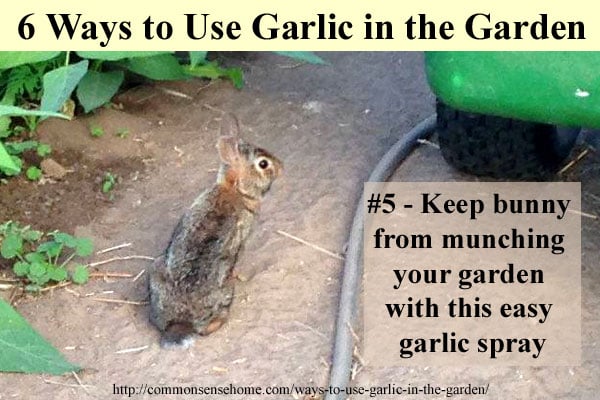
Would you like to save this?
#5 – Use Garlic for Pest Control – Insects and Rabbits
As mentioned above, garlic can be used as an insecticide to control a number of different insects. For pest control, use an oil base so that it sticks better to the problem bugs.
Garlic Pest Control Recipe
Ingredients
- 3-4 ounces of chopped garlic bulbs
- 2 tablespoons mineral oil or olive oil
- 1 pint of water
- 1 teaspoon fish emulsion
Directions
Soak chopped garlic bulbs in oil for a day or so. Strain. Dissolve fish emulsion in water. Add oil to fish emulsion/water mix. Stir well. Store in a glass container. (It will react with metal and plastic.) To use, dilute one part solution to 20 parts water and spray directly on insect pests.
This spray may also help keep bunnies at bay if sprayed on greens that they are munching. Bunnies generally don’t care for strongly scented herbs or fish emulsion.
#6 – Use Garlic for Mosquito Control
There are now a number of garlic based oils that can be sprayed outside to keep mosquitoes at bay, such as Garlic Barrier and Mosquito Barrier. In Carrots Love Tomatoes, the author states that, “A garlic-based oil sprayed on breeding ponds showed a 100 percent kill of mosquito larvae in a University of California experiment.
Note: The experiments seem to indicate best mosquito control with the garlic oil is applied to water surfaces or outside surfaces – not so much when applied to humans or eaten. That said, I know my friends who were big time garlic eaters seemed to get bit less – but it could be coincidence. Experiments also indicate that perfume wearers do attract more mosquitoes, so keep that in mind when enjoying time outside in mosquito season.
And that’s a wrap! If you have any other ways to use garlicky goodness in the garden or yard, let me know.
You may also enjoy:
- How to Grow Garlic – From Planting to Harvest
- Natural Pest Control in the Garden
- Cheesy Garlic Zucchini Bread
Share, Pin or Like to help get the word out about this smelly “garden tool”. 🙂
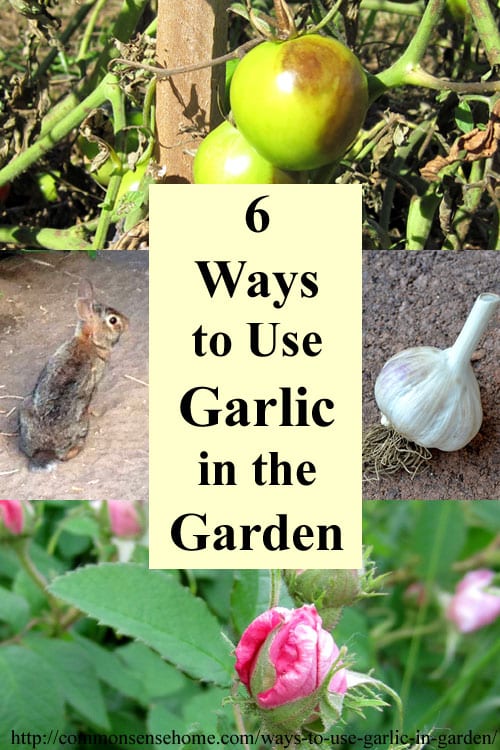
Originally published in 2015, updated in 2017.





Thanks for the garlic tips! I grew and ate garlic for a few years, but discovered I need to eat it raw or it doesn’t digest well,
but it is a bit too intense for my taste buds.. My husband wants some once in a while, and I love the idea of planting it and onions around our fruit trees. Can onions and garlic be planted in proximity? My thought about garlic nixed in oil is that I already knew that mosquito larvae will smother under the film of oil on the water. Maybe garlic will deter the bugs from laying eggs, and any that do get laid will smother under the oil when they hatch. The most effective deterrent I have found for Northern mosquitoes is to put a few drops of peppermint essential oil on cuffs, collars and anywhere the biters might be able to bite through fabric. The aromatherapy effect of keeping us cooler in summer is also a plus. Direct application of pure peppermint oil to skin may be irritating.
While an oil coating would inhibit mosquito larvae, the addition of garlic seems to provide additional impact.
This is the study: “Potential of garlic oil as a biopesticide against all Aedes aegypti life stages”
Thanks for the peppermint oil on cuffs tips. I don’t like applying EOs directly to the skin, as I am very sensitive to them.
Can I break up store bought garlic, and break it up and scatter it around my vegetable plants.
It shouldn’t harm anything. Chopping or grinding the garlic releases more odor and acts as a stronger deterrent.
HI, I live in Northern California near Yosemite in Zone 9. We’re doing a veggie garden for the first time. I want to make a garlic spray for pest control. I’m wondering if I can use a jar of minced garlic or frozen garlic cloves in lieu of peeling a gazillion garlic bulbs. I love short-cuts for things like this.
Sure, that’s fine.
Great article and helpful comments. I wonder with frequent rain if I would need to reapply the garlic spray, if so how frequently? Should I store leftover oil or water based spray in fridge or freezer?
It’s hard to say exactly how frequently it would need to be applied, because that would depend on the rain. Try tasting a leaf of whatever you’re treating. If you can taste garlic, critters can, too. If not, reapply.
For short term storage (a week or less), fridge should be fine. For longer storage, go for the freezer – especially if you try the plant licking option.
You are awesome! Thank you!
You’re welcome.
Great post, thank you 🙂
We’ve had a cat poop problem since we moved to this house almost 2 years ago and I had tried all kinds of deterrents with no luck, however over the past 2 months I’ve starting placing chopped garlic cloves in problem areas and the cats won’t poop where the garlic is, at first I only placed the garlic in the specific spots where the cats had been pooping but I found they would just move to a new location, however after placing chopped garlic all over the dang garden I seem to have eradicated the problem, I still see cats coming and going but no more poop, yay. The garden is a tad whiffy from all the garlic but I LOVE garlic so it doesn’t bother me and no one else has complained (yet) x
I wonder if a garlic spray would work just as well and be easier to apply? Our kitties love freshly tilled soil, too, even with all the many other places they could do their business. Thanks for sharing!
you didn’t really say “how to use garlic” to deter rabbits?
That would be the pest control section. I’ll modify the post to make this clearer.
Hi,
I would like to ask you a favour as to where would I get Canberries plants. I cant find them in ontario, canada.
Please can send me a email on that issue if you don”t mind.
Thanks and have a great weekend.
almas nathoo
Stark Bros Nursery carries cranberry plants – http://www.starkbros.com/products/berry-plants/cranberry-plants/american-cranberry
I’ve read that planting garlic around the perimeter of your yard will help prevent snakes entering, too.
We don’t have poisonous snakes in our area and our yard area is really huge (and I like snakes), but that would be an interesting experiment to try in an area with dangerous snakes.
Good morning,
re: garlic – I remember that when I was growing up on a smallholding in Wales, my mother used to put a couple of peeled garlic cloves into the the chickens’ drinking water to minimise parasite infestations.
All the best,
Rachael
Thanks for sharing! I know some commercial chicken farms have been experimenting with oregano, too.
Great article. Shared. I didn’t think to plant garlic around my fruit trees. Made a note for this fall. 🙂
This is great information. Thank you!